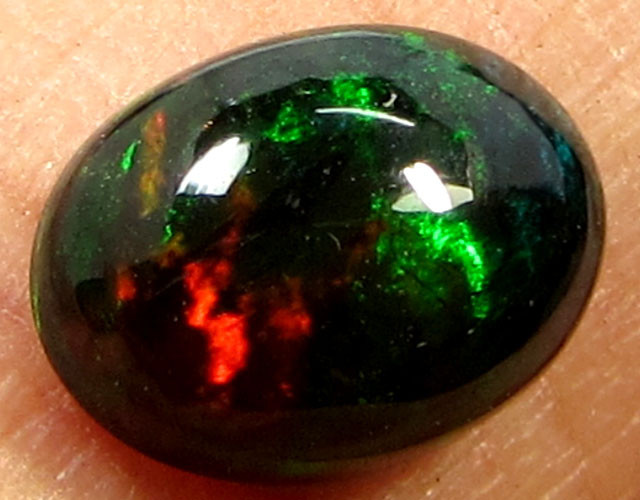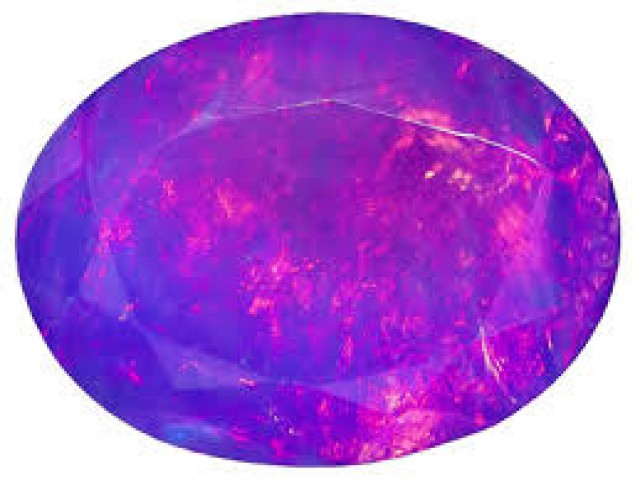
Publié à 9th May 2018
Modifié à 17th Nov 2025
Classification et motifs des opales éthiopiennes
 L'opale éthiopienne est l'une des variétés d'opales les plus diversifiées et spectaculaires actuellement disponibles sur le marché. Étant donné sa relative nouveauté, il n'existe pas encore de méthode de classification standardisée, contrairement à l'opale noire. Cette dernière est classée selon l'intensité de sa couleur noire, sa brillance et ses motifs.
L'opale éthiopienne est l'une des variétés d'opales les plus diversifiées et spectaculaires actuellement disponibles sur le marché. Étant donné sa relative nouveauté, il n'existe pas encore de méthode de classification standardisée, contrairement à l'opale noire. Cette dernière est classée selon l'intensité de sa couleur noire, sa brillance et ses motifs.
De même, l'opale éthiopienne est également classée selon son motif et sa brillance, mais la teinte de fond de la pierre ne joue pas un rôle important dans la détermination de sa valeur finale.
Les opales d'Éthiopie présentent de nombreux motifs uniques, et les descriptions lors des ventes aux enchères d'opales doivent être précises. L'un des motifs les plus recherchés est une ligne potch naturelle avec des inclusions en forme de toile d'araignée, appelée motif nid d'abeille. Ce motif est très rare dans les autres types d'opales. Il arrive également que ces inclusions nid d'abeille présentent une couleur plus vive ou différente de celle de l'opale environnante, un phénomène également rare dans la nature.
Couleur et brillance de l'opale Welo d'Éthiopie
Cela fait référence au feu interne de l'opale. Le feu translucide de ces opales éthiopiennes possède des propriétés qui lui confèrent un aspect tridimensionnel. Cet aspect chromatique en trois dimensions est rare chez la plupart des opales. On a l'impression que le feu est emprisonné au cœur de l'opale.

De nombreuses opales noires australiennes présentent des motifs colorés cachés en leur sein. Ainsi, une opale bleue peut receler des barres de couleur translucides aux nuances violettes ou pourpres, invisibles à l'œil nu. Les opales éthiopiennes, quant à elles, arborent des barres et des motifs de couleur translucides éclatants, d'une luminosité remarquable et parfaitement visibles à l'œil nu.
La valeur des opales d'Éthiopie repose sur l'éclat de leurs reflets irisés. Plus la couleur est vive et intense, plus l'opale est chère. Les pierres aux reflets rouges sont plus rares, tandis que les reflets verts et bleus sont plus fréquents.
Opale noire d'Éthiopie traitée
J'étais au récent salon des gemmes de Bangkok où j'ai vu de grandes quantités d'opale noire d'Éthiopie vendues avec des certificats attestant de leur origine naturelle. Or, de nouvelles découvertes ont révélé que la plupart, voire la totalité, des opales noires d'Éthiopie actuellement sur le marché ne sont pas ce qu'elles paraissent ! Elles sont soit traitées par de nouvelles techniques de fumage innovantes pour obtenir leur aspect d'opale noire, soit, comme cette opale est hydrophane, semble bien réagir au fumage. Les techniques de fumage ne sont pas nouvelles pour l'opale, mais celle utilisée aujourd'hui pour l'opale d'Éthiopie introduit une nouvelle variante de la méthode traditionnelle, ce qui explique pourquoi ce traitement a échappé aux laboratoires de gemmologie réputés.

Cette ancienne technique était utilisée sur des opales de qualité inférieure, comme l'hydrophane mexicaine, pour foncer la couleur du matériau de base, ce qui provoquait – par contraste – un jeu de couleurs plus intense. Elle consistait simplement à envelopper l'opale étroitement dans du papier brun, à la placer dans un récipient fermé, à la chauffer à feu moyen jusqu'à ce que le papier soit complètement carbonisé, puis à la laisser refroidir et à la laver. Le résultat était une opale bien plus belle !
Un autre traitement courant pour l'opale d'Éthiopie consiste à modifier sa couleur de fond à l'aide de teintures. Certaines pierres présentent une couleur rose vif ou violette artificielle.

Il s'agit du seul traitement connu à ce jour pour l'opale d'Éthiopie, et il réduit considérablement le prix de la pierre. Sur Opal Auctions, tout traitement doit être clairement indiqué. En cas de doute, n'hésitez pas à faire appel à notre service d'expertise pour obtenir un second avis.
Il faut également se méfier des fausses opales éthiopiennes actuellement sur le marché. Consultez notre article sur la détection des fausses opales pour acquérir les connaissances nécessaires à leur identification.
Motifs dans l'opale éthiopienne
L'opale d'Éthiopie présente une grande variété de formes et de motifs magnifiques, de l'ovale à la forme libre. Les opales noires d'Australie sont réputées pour leurs motifs uniques, du maquereau à l'arlequin. Des appellations similaires sont utilisées pour décrire les opales d'Éthiopie. Le motif le plus recherché et le plus cher est le motif nid d'abeille.
Cristal à motif large

Patchwork Rolling Flash

patchwork en nid d'abeille

nid d'abeille hexagonal ou écailles de poisson

Pin Fire Crystal

Motif de flash néon

Bienvenue Broad Flash

Motif arc-en-ciel

Large patchwork

Feux d'artifice à paillettes multiples

Feu éclair large

Motif yeux floraux

Nuage de feu

Motif arlequin patchwork Welo
Le motif arlequin est considéré comme le plus rare dans l'industrie de l'opale, l'Éthiopie possédant son propre motif unique : le motif nid d'abeille. Ce dernier est le plus recherché sur les cabochons d'opale éthiopienne. Nombre de mineurs d'opales n'en trouveront jamais un seul au cours de leur carrière.
Le véritable motif arlequin est un motif mosaïque large, composé d'un ensemble angulaire de couleurs rapprochées. Les motifs floraux sont parfois appelés arlequin floral, mais les appellations Welo Floral ou Welo Patchwork seraient plus appropriées pour ces opales éthiopiennes à motif floral.

Achetez des opales d'Éthiopie
Rechercher le Opal Encyclopedia
Enchères associées
Articles Liés
Tous les poèmes figurant sur cette page appartiennent à leurs auteurs respectifs. Toute reproduction non autorisée est interdite.
9th May 2018
Internet a révolutionné nos habitudes d'achat et il est désormais possible d'acheter des opales en ligne. Laissez-nous vous guider : quels critères prendre en compte et comment procéder.
5th Mar 2019
Un doublet d'opale est une fine couche d'opale précieuse collée sur un support, généralement un morceau d'opale noire ou de pierre de fer. Les doublets d'opale constituent une alternative abordable à l'opale massive.
9th May 2018
Derniers articles
Découvrez comment les opales sont classées et quels facteurs influencent leur prix. De la couleur à la brillance, en passant par la taille et l'origine, apprenez comment chaque type d'opale est évalué, avec des exemples de fourchettes de prix.
19th Jul 2023
Embarquez pour un voyage et découvrez le pouvoir guérisseur des opales grâce à notre auteure invitée, Vivien Schapera, spécialiste des techniques de guérison par les cristaux !
20th May 2023
L'opale Reine de Feu est l'opale la plus chère au monde, vendue pour l'équivalent actuel de 3 millions de dollars. Découvrez son histoire et ses qualités !
18th Feb 2023
Catégories d'articles
All there is to know about Opals including Black Opals, Ethiopian Opals & Boulder Opal
14 les articles
Check out our fascinating information and articles on all things amazing in the Opal world
41 les articles
Opal Auctions sellers who are approved as opal Verified Sellers
4 les articles









